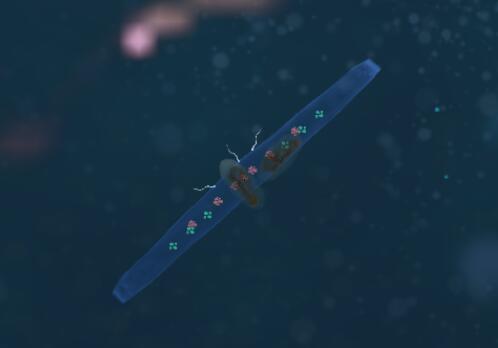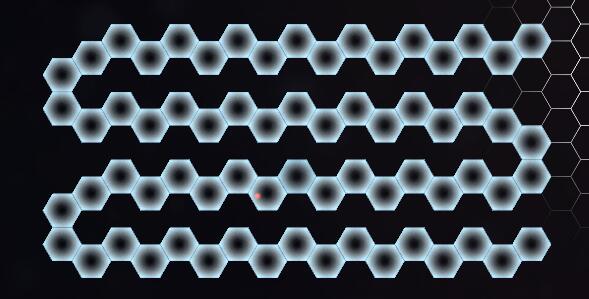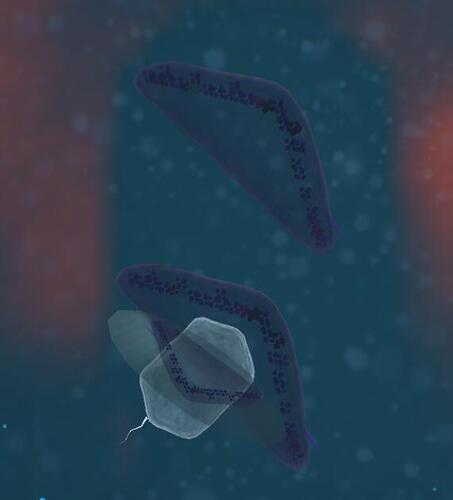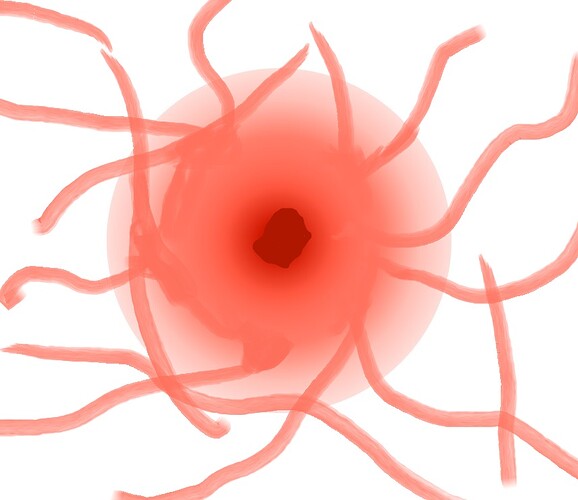hhyrylainen changed his pfp in the development forums?!
Yeah, on Discord too. The new Discord username update thing changed his profile picture so he just decided to go ahead and ensure that the eye truly sees everything now.
Do we know how much the performance has improved in Godot 4 physics engine?
I know that they changed from bullet to there own homebrew version.
I don’t know. If such a benchmark exists, it should hopefully be relatively easy to find with google.
Which has never lead to an increase in bugs… Just kidding, that’s definitely a way to have a fresh batch of new bugs by reimplementing something. Still for us this will be irrelevant if the switch to using an external physics engine goes well. Also funnily enough for Godot 4 there is already a premade integration module to swap out the Godot physics for the Jolt physics engine.
Attempted to design an extremely long rod-shaped cell. Due to the fact that the current engulf ability mainly depends on the size of cells, we will obtain the following situation:

Even if the engulfed cells are reduced, they still exceed the range of predators.
Thank you for the screenshot. It’s pretty reflective of a point in the OP!
Current engulfment , membrane generation and Hitbox:
Based solely on size, it’s still too rough. More consideration should be given to cell shape.
According to the data I have consulted, iron respiration (not the Chemosynthesis with oxygen to iron oxide in the game now. Why does the nature have pure iron, and shouldn’t the reducing agent be Fe2+ ?) is an extracellar respiration, because Fe3+mainly exists in the form of solid precipitation, which means that it is unrealistic for cells to collect and store Fe3+.
Fe3+ can be used as an environmental compound and its concentration can affect the rate of iron respiration. But this homogenizes with oxygen, and the gameplay is too monotonous. (NO3- can do this directly because it participates in the Nitrogen cycle as a play method)
Considering that Fe3+has a certain solubility and mainly exists in the form of solid precipitation, its concentration can be unevenly distributed within the region. In the current game, there are iron blocks (the red ones should look like Fe (OH) 3 precipitates). If there are Fe (OH) 3 precipitates, a decreasing Fe3+concentration will be distributed around them. This concentration can be opened by the chemical receptor to the Fe3+concentration field, unlocking the tendency of AI towards Fe3+behavior.
I would like to know if there is a corresponding embodiment of this surface adjacency bonds in reality. I like this design, perhaps it will encourage cells to wrinkle.
Based on the knowledge I have, if Surface-adjacency bonuses come from adjacent cell membranes, those biochemical reactions that rely on membrane structure should benefit, especially utilizing ATP synthesis for oxidative physiology. Also, will external structures such as flagella affect the Surface-adjacency bonuses of internal structures? They do not affect the internal structure and cell membrane proximity.
A simple and intuitive method for calculating surface area is good and easy to understand. However, when calculating surface area and exposure, it is required that this is also the exposure of the entire cell. Otherwise, players may design a spring, cavity or fishbone. Perhaps it is necessary to use membrane generation for tuning?

One problem is that if the part placement mechanical is added, the existing Organelle replication mechanism will have a greater impact on cell design. The newly copied Organelle will appear outside the cell and destroy the original Surface-adjacency bonuses.
I want to know how this environmental adaptation is reflected. Is it a direct design that specifies the range of environmental conditions that this organism can adapt to, forcing it to only survive within this range? Or is it through environmental and biological design to determine a coefficient (which may resemble a bandtop filter) that, together with cell size or surface area, generates ATP consumption? (The initial conditions of cells can be set to be widely adaptable, so that cells do not need to consider specialized environmental adaptation when their size is small.)
And when players make significant modifications to their species adaptability in order to adapt to the new environment, if the player species remaining in those earlier areas follow the player’s changes, they may experience a large number of deaths. Should they be allowed to independently become new species?
Currently the idea is that this environmental tolerance acts as a range of preferred habitable conditions. If you are in a patch outside of these conditions, you will receive an osmoregulation/energy costs debuff depending on how far away from your preferred ranges you are.
https://forum.revolutionarygamesstudio.com/t/managing-complexity-and-defining-scope/1057
For dealing with the complexity of cells in the macro, perhaps you could remove the unique hand-crafted cell shape and replace it with a simple representation based on check box options and sliders. Such as overall shape like sphere, oval, rod, extra long rod, and etc. Composition like mitochondria density, transport channel density, surface tendrils, and etc. Same could be applied to microbes. Construction of organs could start similarly, with first choosing general shape. Such as shpere, hollow sphere, rod, tube, and etc. After that you would pick from the collection of cells you have made to occupy the organ space. No need to specifically place any single cell in any particular place of the organ tissue. Finally, based on prewritten parameters, the game will decide what organ you are trying to create and give it the characteristics of that organ. Later on cells and organs that meet certain conditions will have further options for more specific cells and organs. Though this will reduce the possibilities of unique cells, unless you want a large amount of non lawk lifeforms, I think it will cover enough organismal diversity to make any biosphere well rounded.
Also for the space stage, biospheres could be made unchanging. Locked to the end result of any of the stages of other player’s games. With the one exception being perhaps the aware stage not having the player’s species. Only other space stage species will have the same abilities as the player species. This will reduce the concern of having to deal with alternate timeline events and organisms along with remove any need to generate a galaxy beyond picking biospheres out of the “thrivepedia”.
Here’s my prediction: this will be the worlds least intuitive system and players will constantly complain about why their creation gets marked as another organ and they are stuck trying to make one specific organ to advance in the game.
how would you make things like Stentor coeruleus - Wikipedia or things with unicellular external organs, i know there will be at least a few people who’d do that, i’m one of them.
Im not sure how this would be the case. You would still be able to alter the organs at the macro scale to make unique characteristics. Im not saying that this would permit organ jumping. It would start with simple things like strips of nerve cells, tubes, simple muscles, simple sensory organs, endocrine tissues and mixes of those. Players would continue tweaking those organs which would open up more unique and specific cells, tissues, and organs. I can’t imagine how someone would just get stuck if they are trying play with in familiar territory and not actively create something that barricade them from the next stage like a web nervous system, no bones, or passive respiration.
If that were to be created, it would happen in the microbe and multicellular stages. But not the aware stage.
what about something with an external organ that is a single cell big enough to be easily seen without any special equipment. also Stentor coeruleus didn’t evolve before multicellular life and it’s big enough that you can see it with just a magnifying glass, so cells being simple shapes in the aware stage would just not work, maybe if they’re below a certain size compared to you, but not throughout the entire stage.
how would being boneless prevent you from reaching the awakening stage, octopi have no bones and they’re almost as smart as humans, can use tools, and have civilizations. if an octopus needed bones for something it could just tie a stick to its tentacle
The player cannot progress as these organisms in the same way you are not entering the awakening stage as a traditional flora. If they are present in the aware stage, it would be the work of the computer.
At that point of evolution, bones would take much time to evolve. I was just thinking of examples to express my thoughts.
tying a stick to your limb takes way less than a generation to do.
the player can most definitely play in aware as an organism with unicellular teeth, unicellular skin, unicellular hairs, unicellular feathers, unicellular horns, unicellular eyes, blood that is a single cell, or just a completely completely unicellular organism with bones replaced by a completely solid or very porous mass made of bone material, a brain made of bacteria that use electricity to communicate, blood vessels being the exact same but made of individual cell with a membrane that has cytoskeletal proteins, a heart with no membranes stopping it from being extremely strong in a small area, and muscles that are just myofibril and mitochondria with blood vessels running through them and anchored to bones, and since the muscles would need nuclei the skeletal ones should either have less myofibril density or have their nuclei be web like to go around the myofibrils
this would all require macroscopic organisms to be able to be made out of one cell through polynucleation or sending plasmids of specific genes to specific places though and currently there are a grand total of zero mods that let you do that and there isn’t actually a system in place stopping a cell from getting infinitely big with one nucleus yet
Please do not double post. Instead, edit your post, as suggested in Rule 8 of the forums;
It just creates unnecessary clutter in the thread to post multiple times without need.
I’m not saying it’s impossible, it just needs a lot of clever ideas on paper to work.
Well, you would be putting your species in a box that it would then have to get out of to progress to the awakening stage.
In terms of completing the game, what would the point of including this be? They can exist in the game as npcs but plugging them in the player controlled editor as an option would be strenuous.
sorry I keep forgetting this.
tying a stick to a tentacle? or are you talking about the cell organs
assuming you’re talking about the part of my post i think you are, that’s like saying for an octopus to use tools it needs to grow bones or saying that you have to have toes to domesticate a species, both are completely and obviously false. as long as the species has a brain comparable in capacity to a human’s, limbs that can hold and use tools, and a size that allows it to not get cooked by trying to cook meat (none of which were specified in the part that you are responding to here) it can progress to and past awakening
allowing the player to fully skip the multicellular stage, allowing the player to be a fungus, allowing the player to still complete the game even if another player dumps nanobots that kill everything multicellular on their planet, allowing the player to have more possible methods of digestion, breathing, and circulation, etc. basically the best and main reason is making sure there’s a way for players to not get softlocked into a stage
there are modders who would try to make it work and i know at least one plans to and if the mod is built well enough it could be added to the base game
please quote the part you’re trying to respond to it makes it far easier to know what you’re talking about and takes less than 5 seconds most of the time

